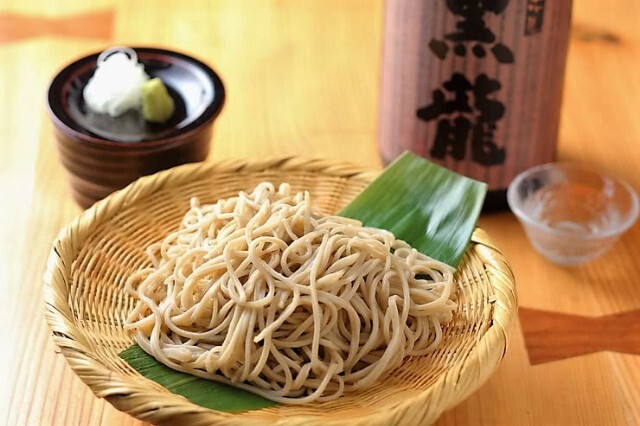![Where to Eat near Shibuya Station - 10 Excellent Restaurants]()
Shibuya is one of Tokyo’s top destinations for visitors and locals alike. A beacon of youth culture and entertainment, the area offers everything from shopping and karaoke to cool bars and lively nightclubs.
Just outside of Shibuya Station is the Hachiko statue dedicated to Japan’s most loyal canine, which has become a popular rendezvous spot for groups of friends meeting up. And the intersection in front of the station, often referred to as “Scramble Crossing” is the busiest pedestrian crossing in the world, with as many as 2,500 people passing through it each time the traffic light changes. But Shibuya isn’t only a place to go for fun shopping and entertainment, it’s home to trendy cafés and numerous restaurants that provide a wide range of cuisines. If you’re wondering where to eat near Shibuya station, here’s a handy guide.
Continue reading Where to Eat near Shibuya Station - 10 Excellent Restaurants
![Hanami Guide: Where to see Cherry Blossoms in Tokyo, Kyoto & Osaka]()
Cherry blossom season in Japan begins each year in early spring, lasting until around Golden Week in May. During that time, swaths of pink and white sakura blossoms burst into full bloom starting from the Kyushu area in the southwest and moving in a northerly direction. During this season hanami, or cherry blossom viewing parties, are common in Japan. Sakura viewing first began during the Heian period, the historical peak of the Japanese nobility and a period in which culture and the arts flourished in Japan. The Heian emperor would host extravagant feasts beneath the cherry blossoms at the imperial palace in Kyoto, which set the tradition for hanami picnics. Today, hanami parties can take place either during the daytime or at night among family, friends, and coworkers.
Continue reading Hanami Guide: Where to see Cherry Blossoms in Tokyo, Kyoto & Osaka
![Tokyo Tower Restaurants - 8 Places to Feed a Towering Appetite]()
Tokyo Tower is one of the most famous silhouettes on the Tokyo skyline. Modeled after the Eiffel Tower in Paris, the iconic structure—which functions as a communications and observation tower—stands approximately 333 meters (about 1,090 feet) tall. Although Tokyo Tower has been superseded as a broadcasting tower by the taller Tokyo Skytree, which opened in 2012, it is still a favorite landmark for travelers to add to their list.
Continue reading Tokyo Tower Restaurants - 8 Places to Feed a Towering Appetite
![Tokyo Skytree Restaurants - 12 Excellent Places to Eat]()
At 634 meters (over 2,000 feet), the Tokyo Skytree is the tallest structure in Japan, and the second-tallest in the world. The Tokyo Skytree is distinct in its neo-futuristic design, which provides a unique contrast to the traditional architecture of shrines and temples in the surrounding area. Visitors can enjoy a fantastic view of Tokyo city from the two observation decks located 300 meters and 450 meters up, and on a clear day one can see all the way to Mount Fuji in the distance. At the base of Tokyo Skytree is the Solamachi shopping center with over 300 shops, providing plenty of opportunities for souvenir shopping, and once you’ve worked up an appetite, there’s many restaurants near Tokyo Skytree to satisfy all tastes.
Continue reading Tokyo Skytree Restaurants - 12 Excellent Places to Eat
![Tokyo Station Restaurants Offer Portals into World Cuisine]()
Tokyo Station is often described as the figurative center of Japan, the heart that connects the capital metropolis of Tokyo to the rest of the country via its many arteries of bullet train lines. Over 3,000 trains run through the station each day, and it is the fifth busiest in the world by number of passengers. Tokyo Station’s iconic Marunouchi facade is a traditional red brick building often likened to the Amsterdam Central Station as well as Victorian period London architecture, and it gives way to the Imperial Palace just a short distance away.
Continue reading Tokyo Station Restaurants Offer Portals into World Cuisine
![Where to Eat Sushi in Tokyo: A Neighborhood Guide]()
When dining in Japan’s metropolitan capital of Tokyo, there are few foods more native to the city than sushi. Tokyo is the birthplace of nigiri-style sushi, the iconic ball of vinegared rice topped with a beautiful cut of fresh fish or other seafood, which developed as a lunchtime food for laborers, merchants, and artisans during the 1800s. Nigiri sushi is also known as Edomae sushi, after Tokyo’s former name, “Edo”.
Continue reading Where to Eat Sushi in Tokyo: A Neighborhood Guide
![Best Soba in Tokyo: 5 Recommended Noodle Restaurants]()
Soba is a type of noodle that has been eaten in Japan for centuries. Long and thin, soba noodles have an appearance similar to spaghetti, however are a little chestnut in color and nutty in flavor, as they are made from buckwheat flour rather than wheat flour. The use of buckwheat flavor also makes soba lower in calories than other types of noodles, as well as being an excellent source of fiber and protein. Soba noodles can be prepared from dried factory-cut noodles or eaten fresh and hand-cut, known as “te-uchi soba”.
Continue reading Best Soba in Tokyo: 5 Recommended Noodle Restaurants
![Grilled Glory: The Best Yakiniku in Shinjuku and Shibuya]()
Yakiniku is a Japanese-style of barbecue dining. It’s characterized by a tableside charcoal brazier or a gas grill where customers can cook their own cuts of meat and vegetables. Yakiniku became popular in Japan during the early Showa period, influenced by Korean barbecue dishes like bulgogi, which were brought to Japan by Korean immigrants. Over time, yakiniku evolved into its own Japanese style of barbecue, featuring unique cuts of meat and Japanese dipping sauces called “tare”. One feature of the Korean origins that does hold strong is the assortment of side dishes like kimchi offered with yakiniku—albeit sweeter and less spicy versions have been adapted for the Japanese palate.
Continue reading Grilled Glory: The Best Yakiniku in Shinjuku and Shibuya
![15 Great Ginza Restaurants: French Fusion, Izakaya and More]()
Both in Japan and worldwide, Ginza is a place synonymous with material luxury, discerning artistic taste and culinary delights. While people today flock to Ginza’s upscale department stores, art galleries and fashionable boutiques, it has also historically been a place where Tokyo’s artisans, painters, and noh and kabuki actors go to experience its refined international atmosphere and cafe-lined streets. Avenues close to vehicle traffic on weekends so that shoppers and artistic types alike can amble through the promenade at a leisurely pace.
Continue reading 15 Great Ginza Restaurants: French Fusion, Izakaya and More
![Best Tempura in Tokyo: 13 Bastions of Golden-fried Goodness]()
Tempura, a tantalizing assortment of battered and deep-fried ingredients, is already one of Japan’s most world-renowned dishes. What many people outside of Japan don’t realize, however, is that there are a number of regional differences when it comes to this famous dish. The western Kansai region favors vegetable tempura fried in neutral oil and served with salt, while tempura from the Kanto region in the east includes both seafood and vegetables, fried in sesame oil for a golden color and served with a soy sauce-based dipping sauce. For most visitors to Japan, it’s this Kanto-style that comes to mind when they think of tempura—large golden battered prawns, crisp tempura vegetables, and a flavorful dipping sauce.
Continue reading Best Tempura in Tokyo: 13 Bastions of Golden-fried Goodness











